
NSF Project
GEPR: The Origin and Evolution of Sex Chromosomes in Caricaceae
PI: Ray Ming (UIUC) Co-PI’s: Paul Moore (HARC), Qingyi Yu (Texas A&M), and Richard Moore (Miami University)
Background information
Papaya (Carica papaya L.) is a member of the small family Caricaceae within the order Brassicales. There are 6 genera and 35 species in the Caricaceae, and 32 species are dioecious. The three exceptions include two trioecious species, C. papaya and V. cundinamarcensis, and one monoecious species V. monoica. This appears to suggest that dioecy is the basal condition for the family and that the presence of a hermaphroditic sex form is a derived trait in C. papaya and V. cundinamarcensis. It raises some interesting questions for the origins of dioecy and sex chromosomes in Caricaceae. Is the genetic mechanism of sex determination shared among all members of the Caricaceae? If so, did sex chromosomes evolve independently in C. papaya or can they be found in other species? If other species do have non-recombining regions harboring sex-linked genes how does the size and extent of these regions compare to that of C. papaya? Answers to these questions are possible through comparative genomics of the MSY region among Caricaceae species with different sexual reproductive mechanisms. In particular, Vasconcellea harbors monoecious, dioecious, and trioecious species.
Sex chromosomes have evolved multiple, independent times in all major eukaryotic lineages—plants, animals, and fungi. While the genetic basis of sex determination and sexual dimorphism can vary considerably in these diverse lineages, the same fundamental steps seem to guide the emergence and evolution of sex chromosomes. In the case in which males are determined by a single dominant Y chromosome, the initial step in sex chromosome formation is an inhibition of recombination between two sex determining loci, one that suppresses female expression and the other that promotes male expression. These sex determination loci are permanently linked in a region of suppressed recombination on one of a pair of autosomes, the “proto-Y”. Following the emergence of the Y, sexually antagonistic loci (which benefit males over females) are recruited to its non-recombining region from either the same or different chromosomes. The absence of recombination, however, reduces the efficacy of selection to act on the Y, effectively forcing the Y to propagate clonally. This slows adaptive evolution, reduces the ability to combine beneficial mutations, and relaxes purifying selection on the Y, leading to the accumulation of deleterious mutations and, ultimately, the deterioration of the Y.
Project summary:
Sex expression in papaya is controlled by loci in the male- or hermaphrodite-specific region of the Y or Yh chromosome (MSY or HSY). Unlike other ancient sex chromosomes, the HSY of papaya is about 2-3 million years old and restricted to a small region about 8.5 Mb. Thus, the papaya sex chromosomes offer the opportunity to understand the early events in sex chromosome evolution. Moreover, sex reversal mutants indicate that the two sex determination genes are confined to a small region of about 1 Mb that is being sequenced, which makes the identification of sex determination genes feasible. Our long-term objective is to understand the evolutionary mechanisms governing the formation and divergence of sex chromosomes. Our specific objectives are: 1) Identify the sex determination genes in C. papaya. We will focus on the candidate genes in the 1 Mb deleted region of the male to female sex reversal mutants to identify the two sex determination genes; 2) Elucidate the origin of sex chromosomes in Caricaceae. We will perform a comparative genomic analysis in six species from three genera with diverse breeding systems and determine whether the sex chromosomes of papaya share a similar evolutionary history with the homologous regions in these sister species. 3) Determine the forces that have shaped genomic evolution of papaya sex chromosomes. We will distinguish between competing evolutionary hypotheses concerning the deterioration of the MSY by conducting population genomics analyses across the entire region and the corresponding region on the X chromosome. 4) Engineer true breeding hermaphrodite papaya varieties. This will improve papaya productivity while lowering cultivation costs. We will transform the sex determination gene promoting stamen development into female plants of leading papaya cultivars to produce hermaphrodite varieties without the Yh chromosome.
Links to download DNA sequences:

NSF Award #0922545
Some photos courtesy of USDA, ARS, IS photo division Designed by James Walsh, last modified 8-10-11



